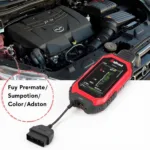OBD2 CAN messages are the backbone of modern vehicle diagnostics. They’re the silent language your car speaks, conveying crucial information about its health and performance. Understanding these messages unlocks a deeper level of control and insight for both car enthusiasts and professional mechanics.
Decoding the Language of Your Car: What are OBD2 CAN Messages?
The Controller Area Network (CAN bus) is a robust communication system used in most modern vehicles. It allows various electronic control units (ECUs), like the engine control module, transmission control module, and ABS module, to talk to each other. OBD2, or On-Board Diagnostics II, taps into this network, using standardized CAN messages to retrieve diagnostic information. These messages are essentially data packets transmitted over the CAN bus, containing specific parameters and values related to the vehicle’s operation.
Think of it like this: each CAN message is a short sentence with a specific meaning. Your OBD2 scanner acts as a translator, interpreting these messages and presenting them in a human-readable format.
What can you learn from these messages? Everything from engine speed and coolant temperature to fuel pressure and emissions data. By accessing this information, you can identify potential problems, monitor performance, and even customize certain aspects of your vehicle. obd2 can bus messages provides further in-depth information on this complex topic.
Different Types of OBD2 CAN Messages
Not all OBD2 CAN messages are created equal. They come in different formats and carry varying levels of detail. Here are some key distinctions:
- Standard OBD2 PIDs: These are standardized Parameter IDs that provide access to common vehicle data. They are defined by the SAE J1979 standard and are supported by most OBD2 scanners.
- Manufacturer-Specific PIDs: These are unique codes used by individual car manufacturers to provide access to more detailed and specialized information. They offer deeper insights into the workings of a specific vehicle make and model.
- Single Frame Messages: These are short, 8-byte messages containing a limited amount of data. They are commonly used for real-time data monitoring.
- Multi-Frame Messages: These are longer messages, spanning multiple frames, used for transmitting larger chunks of data, such as diagnostic trouble codes or complex sensor readings.
Understanding these different message types is essential for effectively using an OBD2 scanner and interpreting the data it provides.
How to Interpret OBD2 CAN Messages?
Interpreting raw CAN messages can be daunting. Luckily, most OBD2 scanners handle the heavy lifting, translating the data into user-friendly formats. ctbtc obd2 scanner came up with that code can assist you in understanding certain trouble codes. However, understanding the basics of CAN message structure can be beneficial.
Each message contains an identifier (ID) that specifies the type of data being transmitted, and a data field containing the actual values. Specific software or online databases can help you decode these raw messages and understand their meaning.
“Understanding the underlying structure of CAN messages empowers you to go beyond simple code reading and truly delve into the diagnostics of your vehicle,” says Alex Walker, Senior Automotive Engineer.
Using OBD2 Scanners to Access CAN Messages
OBD2 scanners are the gateway to accessing and interpreting these crucial messages. From basic code readers to advanced professional scan tools, a wide range of options is available. Choosing the right scanner depends on your needs and level of expertise. foxwell obd2 nt301 is a good example of a capable scanner.
can obd2 read 2 devices at once explores the possibilities of reading data from multiple sources simultaneously.
Advanced Applications of OBD2 CAN Messages
Beyond simple diagnostics, OBD2 CAN messages are being used in innovative ways:
- Vehicle Performance Tuning: Modifying CAN messages can adjust engine parameters and optimize performance.
- Fleet Management: Tracking vehicle data, such as location, speed, and fuel consumption, for efficient fleet operations.
- Data Logging and Analysis: Recording CAN message data for in-depth analysis and performance evaluation.
“The potential of OBD2 CAN messages extends far beyond simple diagnostics, opening up new possibilities for vehicle customization and data-driven insights,” comments Dr. Sarah Chen, Automotive Systems Researcher. kali obd2 explores some more advanced uses.  Advanced OBD2 Applications
Advanced OBD2 Applications
Conclusion
OBD2 CAN messages are the language of your car, offering valuable insights into its inner workings. By understanding these messages and leveraging the power of OBD2 scanners, you can unlock a new level of control over your vehicle’s performance, diagnostics, and maintenance. Understanding obd2 can messages is essential for any car enthusiast or professional mechanic.
FAQ
- What is the difference between OBD2 and CAN?
- How can I access manufacturer-specific PIDs?
- What software can I use to decode raw CAN messages?
- Are all OBD2 scanners compatible with all vehicles?
- What are some common uses for OBD2 CAN messages?
- How can I learn more about specific CAN message IDs?
- Can I damage my car by modifying CAN messages?
Common OBD2 CAN Message Issues
- Lost Communication: Problems with the CAN bus wiring or a faulty ECU can lead to lost communication.
- Incorrect Data: Damaged sensors or faulty wiring can result in inaccurate data being transmitted.
- Intermittent Issues: Loose connections or intermittent sensor failures can cause intermittent problems that are difficult to diagnose.
Further Exploration
Explore related topics like “OBD2 protocols” and “CAN bus troubleshooting” to expand your knowledge.
Contact us via WhatsApp: +1(641)206-8880, Email: [email protected] or visit us at 789 Elm Street, San Francisco, CA 94102, USA. Our 24/7 customer support is ready to assist you.
